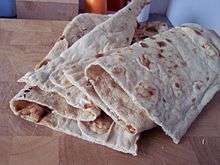Sangak
|
Sangak flatbreads | |
| Alternative names | Nan-e sangak |
|---|---|
| Type | Flatbread |
| Place of origin | Iran |
| Main ingredients | Wheat flour, Sour dough |
| Other information | National bread of Iran |
|
| |

Sangak (Persian: سنگک, Azerbaijani: Səngək; or nan-e sangak نان سنگک) is a plain, rectangular, or triangular Iranian whole wheat leavened flatbread.[1]
History
Its name consists of two parts: 'Sang' in Persian means stone or pebble and 'sangak' means little stone. The bread is baked on a bed of small river stones in an oven. There are, normally, two varieties of this bread offered at Iranian bakeries: the generic one which has no toppings; and the more expensive variety which is seed bread (this is, topped with poppy seeds and/or sesame seeds).[2]
Sangak bread was traditionally the bread of the Persian army. It is mentioned for the first time in the 11th century. Each soldier carried a small quantity of pebbles which at camp were brought together with the "sangak oven" and used to cook the bread for the entire army. It was eaten along with lamb kabab.
The bread has always been widely eaten in the territory of present day Iran and Azerbaijan, but following the Soviet takeover in 1920, the bread fell into some disuse.[3] Because sangak is made by hand, the Soviets opted for mass production of loaves, which option was not doable for sangak bread.[3] Sangak in neighboring Iran however, remained having its same popularity.[3]
See also
- Lavash, a common Armenian unleavened bread
- Barbari bread, Iranian leavened white bread
- Taftan, an Iranian bread
References
- ↑ "Making Iranian Bread in Manoush Cuisine". Manoush Cuisine. Retrieved 2016-03-26.
- ↑ "Breads of Iran". Food Reference. Retrieved 2016-03-26.
- 1 2 3 "Bread - Chorak". Azerbaijan International. Retrieved 2016-03-26.
External links
-
 Media related to Sangak at Wikimedia Commons
Media related to Sangak at Wikimedia Commons

